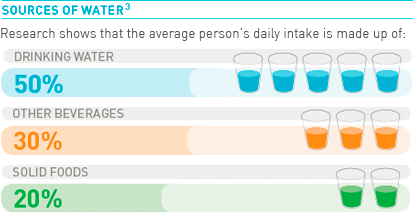
Hydration and variety
Keeping our bodies adequately hydrated is extremely important but is often neglected in the day-to-day busy lives most of us lead.
Water plays many important roles within the body, including transport of nutrients and waste, lubricating the brain and joints, and regulating body temperature. As humans we cannot live without drinking for more than a few days. If we become dehydrated, the effects can be felt in all the major organs of the body, including our brains, intestines, heart, and kidneys.
However for many of us, plain water is not something we want to drink all day, every day, and drinking a variety of drinks is great for making hydration more enjoyable and easier to incorporate into our daily routine.

Hydration & beverages
The role that beverages, including the variety of beverages consumed, play in providing water in the diet has been recognized by international organizations such as the International Life Sciences Institute (ILSI)1 and the European Food Safety Authority (EFSA)2 and it is of special importance for population groups that are especially vulnerable to dehydration such as children, elderly people and people taking certain medications.
dehydration such as children, elderly people and people taking certain medications.
Drinks other than plain water can contain calories, which should be kept in mind. However a great variety of no-calorie and low-calorie drinks are available and Guideline Daily Amounts (GDAs) are available in most countries to help people to make informed choices about the products they buy for themselves and their families.
What can we drink to stay hydrated?
Water
Tap water is safe in many parts of the world and there is now a huge variety of bottled waters, some of them flavoured, available in most locations.
Soft drinks
A soft drink is a non-alcoholic beverage that can be fizzy or still, and may contain flavourings, sweeteners and other ingredients. Beverages like colas, iced tea, lemonade, squash, sparkling water and fruit punch are among the most common types of soft drinks. Soft drinks typically have between 90 to 99% water content. A common misconception is that caffeinated soft drinks can dehydrate us, but these drinks usually contain only small amounts of caffeine and are 90% or more water, so are also good for keeping us hydrated.
Juices
The name fruit juice is reserved for drinks that are 100% pure fruit juice and contain sugars taken from the fruit, either sucrose, fructose or glucose. Other juice drinks can contain some juice along with added water and either caloric or non-caloric sweeteners.
Infusions
Teas and coffees have a very high water content and can help us remain adequately hydrated.
Sport drinks
Sport drinks are intended to reduce water, mineral and energy imbalance due to physical exertion. These drinks contain small amounts of carbohydrates (sugars) and electrolytes, including sodium and potassium. These drinks are popular choices for those of us who exercise.
Those who drink fewer than 3 different beverages per day are less likely to reach the adequate intake for water.
*Note that these values are approximations only and values will depend on source of the food, cooking method, etc. For example pasta cooked “al dente” (Italian style) will have a slightly lower water content than shown here* and is between 50 and 60%. There are many good online databases that will give food composition values for a much wider range of foods.
| Water content in common foods and beverages4* | |
|---|---|
| Type of food | Water content |
| Non-alcoholic beverages | |
| Water, tea, coffee, light refreshments, sports drinks, soft drinks, lemonade, vegetable juice | 85% to 100% |
| Milk, fruit juice | 85% to 90% |
| Alcoholic beverages | |
| Beer and wine | 85% to 95% |
| Distilled | 60% to 70% |
| Soup | |
| Consommé, onion, meat and vegetable, vegetables, tomato, mushroom cream, Noodle with chicken, vegetable concentrate, concentrated soups, mushrooms cream (made with milk) | 80% to 95% |
| Fruits and vegetables | |
| Strawberry, melon, grapefruit, grape, peach, pear, orange, apple, cucumber, lettuce, celery, tomato, pumpkin, broccoli, onion, carrot | 80% to 95% |
| Banana, potato, corn | 70% to 80% |
| Dairy products | |
| Fresh whole milk | 87 to 90% |
| Yoghurt | 75% to 85% |
| Ice creams | 60% to 65% |
| Cheese | 40% to 60% |
| Cereals | |
| Rice (boiled) | 65% to 70% |
| Pasta (spaghetti, macaroni, noodles) | 75% to 85%* |
| Bread, cookies | 30% to 40% |
| Breakfast cereals (ready to eat) | 2% to 5% |
| Meat, Fish, Eggs | |
| Fish and seafood | 65% to 80% |
| Eggs (scrambled, fried, poached), omelette, egg substitute | 65% to 75% |
| Beef, chicken, lamb, pig, veal | 40% to 65% |
| Cured meat, bacon | 15% to 40% |







